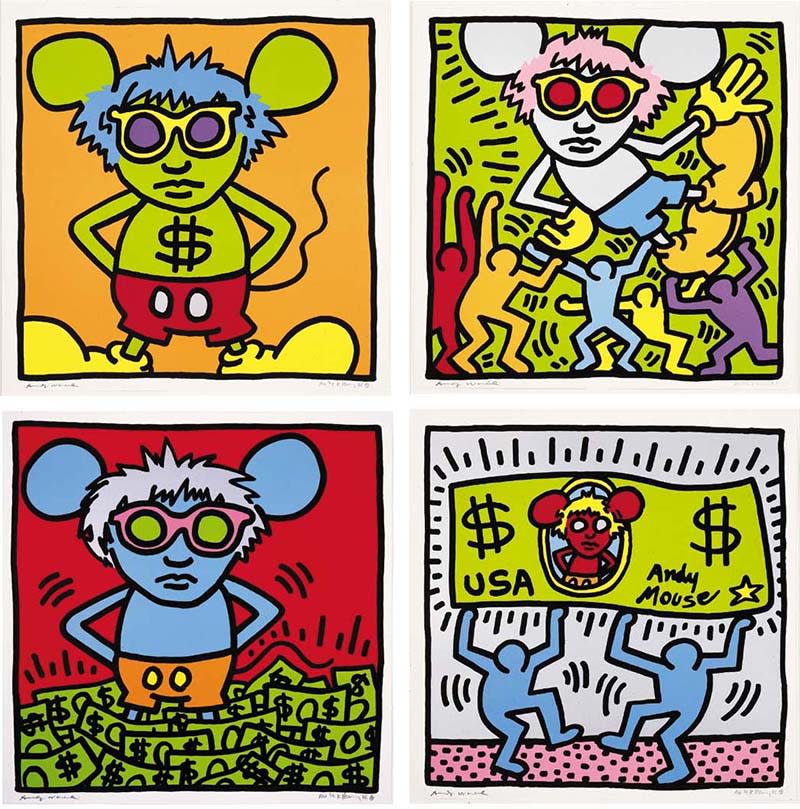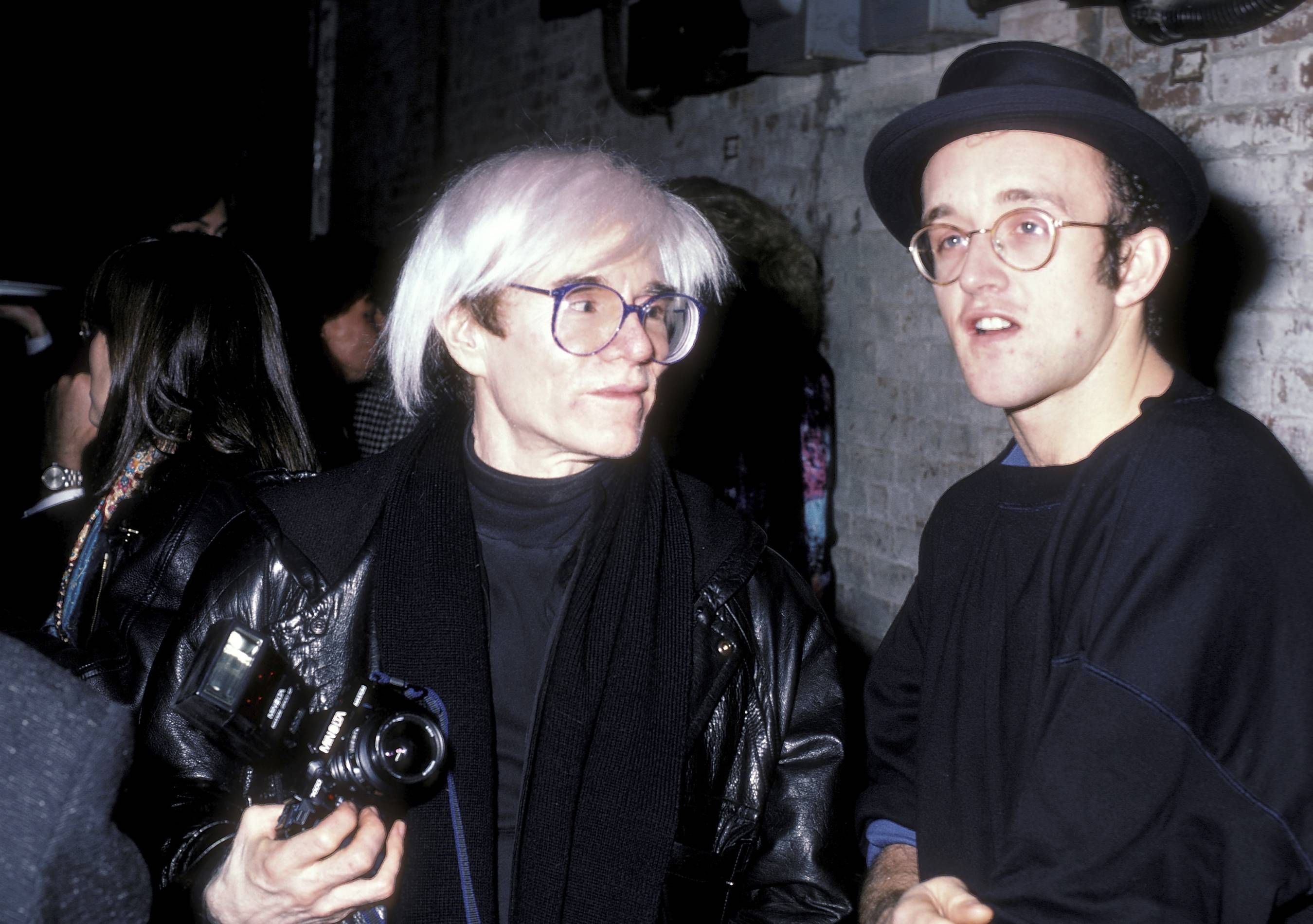In the pantheon of 20th-century art, Keith Haring and Andy Warhol stand as titans of visual culture—two artists who revolutionized how art intersects with popular media, celebrity, activism, and the streets. Though they came from different generations and entered the art world through different doors, their lives and careers converged in 1980s New York City in a relationship that was part friendship, part mentorship, and part creative collaboration.
Their bond was more than a footnote in art history; it was a symbolic passing of the torch and a vibrant fusion of pop sensibilities that helped define the aesthetics and values of the era.
An Unexpected Friendship: Generational Bridge
Keith Haring arrived in New York City in 1978 to study at the School of Visual Arts (SVA), at a time when Andy Warhol was already a global icon. Warhol, the enigmatic king of Pop Art, had made his name in the 1960s with his screen prints of Campbell’s soup cans and Marilyn Monroe, and had cultivated a persona that blurred the lines between celebrity and artist.
Haring, by contrast, emerged from the street—chalk drawings on subway walls, activist murals, and spontaneous linework that thrived in the raw, underground energy of the downtown art scene. While Haring initially idolized Warhol from afar, their worlds collided in the early 1980s through mutual friends and shared gallery circles.
The connection between them was immediate and genuine. Warhol was intrigued by Haring’s enthusiasm, sincerity, and graphic style. Haring, meanwhile, was fascinated by Warhol’s status, history, and ability to use art to comment on culture. Despite their age gap of over 30 years, the two developed a deep friendship based on mutual admiration and creative curiosity.

Mutual Influence and Artistic Kinship
Although Haring was significantly younger, their artistic philosophies overlapped in many ways. Both artists believed in breaking down the barrier between high art and mass culture, and both embraced commercial media and repetition as tools of visual communication.
-
Warhol saw the world through the lens of consumerism and fame. His silk-screened prints of celebrities, dollar signs, and brand logos challenged traditional ideas of originality and artistic value.
-
Haring, while more overtly political, also used repetition and iconic symbols—the radiant baby, barking dog, flying saucers—as tools for mass communication. He wanted his work to be accessible to everyone, not just gallery-goers or collectors.
Warhol was drawn to Haring’s energy and how his art captured the spirit of a new generation. Haring, in turn, took inspiration from Warhol’s ability to merge art, branding, and celebrity into a powerful cultural force. Haring even described Warhol as his “biggest influence,” calling him “the only person in the art world I ever really wanted to meet.”
Collaborations: Art as Dialogue
One of the most significant manifestations of their relationship was the art they created together. While they never embarked on massive joint projects in the way of, say, Basquiat and Warhol, their collaborative works were intimate, playful, and reflective of their bond.
"Andy Mouse" Series (1986)
Haring’s most well-known artistic tribute to Warhol came in the form of his “Andy Mouse” series—a fusion of Warhol’s image and Disney’s Mickey Mouse, two of the most recognizable pop icons of the 20th century. The series depicted Warhol’s face on a cartoonish Mickey Mouse body, often set against backgrounds filled with dollar signs or colorful geometric patterns.
“Andy Mouse” was more than a clever mashup. It was Haring’s affectionate homage to Warhol’s influence, fame, and commercialization. It critiqued and celebrated Warhol at the same time—acknowledging his place as a commercial icon while elevating him to mythic pop status. The images were produced using silkscreen, Warhol’s signature technique, further cementing the conceptual connection.
Warhol approved of the series and posed for Haring during its development. The works were eventually printed in editions and became some of Haring’s most sought-after prints.
Polaroids and Portraits
Warhol, an obsessive documentarian, frequently photographed Haring, including Polaroid portraits that have become part of his extensive visual diary of the downtown scene. Warhol painted several portraits of Haring, including a memorable one where Haring poses with his dog, featured in bright, flat Warholian color blocks.
These portraits were part of a larger tradition in Warhol’s work, but with Haring, they also captured the deep friendship and mutual fascination between the two.

Warhol’s Role as a Mentor
To Haring, Warhol was more than a collaborator—he was a mentor figure. As Haring's fame grew, he found himself navigating the commercial art world that Warhol had helped define. Warhol offered guidance and support, and his experience helped Haring avoid many pitfalls of rapid celebrity.
Yet Haring never became a Warhol clone. While he embraced merchandise and mass production—opening the Pop Shop in 1986, in part inspired by Warhol’s Factory and his embrace of art-as-product—Haring retained a commitment to activism that distinguished his work. His murals against apartheid, his support for LGBTQ+ rights, and his advocacy during the AIDS crisis gave his art a moral urgency that complemented Warhol’s cooler detachment.
Their relationship, then, wasn’t just student and master—it was a meeting of equals, each learning from the other, each responding to the cultural moment in his own voice.

The AIDS Crisis and Their Final Years
The 1980s were a time of creative explosion but also devastating loss. The AIDS epidemic ravaged the artistic community, taking the lives of many of Haring and Warhol’s friends. Warhol died suddenly in 1987 at age 58, following complications from gallbladder surgery. His death deeply affected Haring.
Just one year later, in 1988, Haring was diagnosed with AIDS. Rather than retreat, he intensified his activism and used his work to promote awareness, understanding, and compassion. He founded the Keith Haring Foundation in 1989 to support AIDS organizations and children’s programs.
In his final works, especially murals and public art, Haring’s urgency and vulnerability came through. Warhol’s influence remained present, but Haring had by then carved out a wholly distinct and powerful artistic voice.
Legacy: Parallel Icons
The friendship between Keith Haring and Andy Warhol was brief in the span of time, but immense in cultural weight. They both died too young—Warhol at 58, Haring at 31—but their impact continues to ripple across art, design, fashion, and activism.
Together, they demonstrated that art could live outside the confines of museums and galleries. They blurred the lines between artist and brand, activism and expression, underground and mainstream. They helped redefine what it meant to be a pop artist in the late 20th century.
Today, their works are exhibited in major institutions around the world, but their stories are most alive in the energy of the street, the rhythm of nightlife, and the belief that art can be for everyone.



